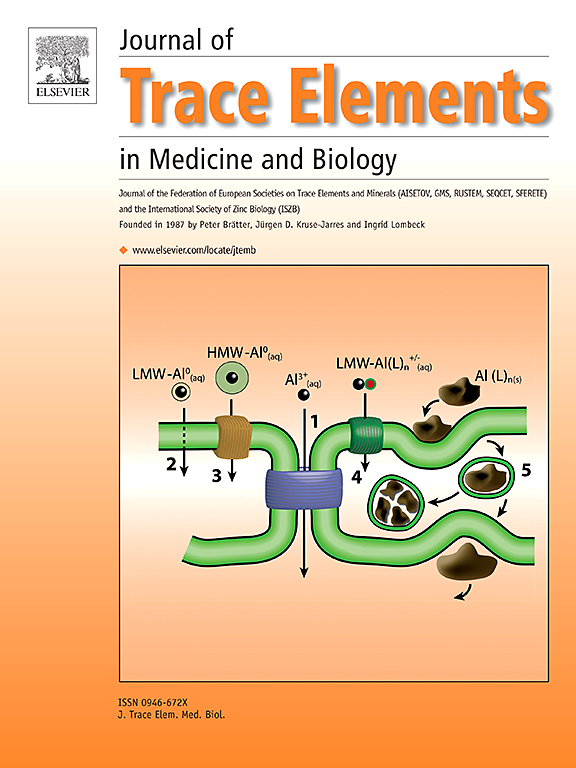A selenomethionine deficient, high-fructose diet does not lead to cardiometabolic disorder in the selenocysteine lyase knockout mice
IF 3.6
3区 医学
Q2 BIOCHEMISTRY & MOLECULAR BIOLOGY
Journal of Trace Elements in Medicine and Biology
Pub Date : 2025-06-18
DOI:10.1016/j.jtemb.2025.127685
引用次数: 0
Abstract
Background/purpose
High-fructose consumption is a driver of cardiometabolic disorders and metabolic syndrome, and selenium (Se) deficiency further increases the risk of developing these diseases. Consuming high amounts of fructose induces insulin resistance and oxidative stress, and alters the cardiac lipidome. Se may reduce the detrimental impacts of fructose through its incorporation into selenoproteins like the glutathione peroxidases 1 and 4, (GPX1,4) and the thioredoxin reductase 1 (TXNRD1) whose primary function is to curb oxidative stress. When Se levels are limited, selenocysteine lyase (SCLY) decomposes selenocysteine (Sec) to hydrogen selenide (H2Se), and loss of Scly results in metabolic syndrome in mice. However, it is unknown if SCLY is required to sustain the synthesis of critical antioxidant selenoproteins to prevent oxidative stress, cardiometabolic disorders, and metabolic syndrome caused by high-fructose consumption.
Methods
In this study, we analyzed cardiometabolic parameters, the cardiac lipidome, and the cardiac protein levels of GPX and TXNRD in male and female whole-body Scly knockout (Scly KO) mice fed a selenomethionine (SeMet) deficient, high-fructose diet.
Results/conclusion
We found that selenomethionine deficiency, coupled with high-fructose consumption does not lead to cardiometabolic disorder in the Scly KO mice, and suggests that there are compensatory mechanisms involving Se metabolism that are protective against fructose-induced cardiometabolic disorder.
硒代蛋氨酸缺乏、高果糖饮食不会导致硒代半胱氨酸裂解酶敲除小鼠的心脏代谢紊乱
背景/目的高果糖摄入是心脏代谢紊乱和代谢综合征的驱动因素,而硒(Se)缺乏进一步增加了患这些疾病的风险。摄入大量果糖会引起胰岛素抵抗和氧化应激,并改变心脏脂质组。硒可以通过将果糖掺入谷胱甘肽过氧化物酶1和4 (GPX1,4)以及主要功能是抑制氧化应激的硫氧还蛋白还原酶1 (TXNRD1)等硒蛋白中来减少果糖的有害影响。硒水平受限时,硒化半胱氨酸裂解酶(SCLY)将硒化半胱氨酸(Sec)分解为硒化氢(H2Se), SCLY缺失导致小鼠代谢综合征。然而,目前尚不清楚SCLY是否需要维持关键抗氧化硒蛋白的合成,以防止氧化应激、心脏代谢紊乱和高果糖摄入引起的代谢综合征。方法在本研究中,我们分析了饲喂硒代蛋氨酸(SeMet)缺乏、高果糖饮食的雄性和雌性全身Scly敲除(Scly KO)小鼠的心脏代谢参数、心脏脂质组以及GPX和TXNRD的心脏蛋白水平。结果/结论我们发现硒代蛋氨酸缺乏和高果糖摄入不会导致Scly KO小鼠的心脏代谢紊乱,这表明硒代谢存在代偿机制,对果糖诱导的心脏代谢紊乱具有保护作用。
本文章由计算机程序翻译,如有差异,请以英文原文为准。
求助全文
约1分钟内获得全文
求助全文
来源期刊
CiteScore
6.60
自引率
2.90%
发文量
202
审稿时长
85 days
期刊介绍:
The journal provides the reader with a thorough description of theoretical and applied aspects of trace elements in medicine and biology and is devoted to the advancement of scientific knowledge about trace elements and trace element species. Trace elements play essential roles in the maintenance of physiological processes. During the last decades there has been a great deal of scientific investigation about the function and binding of trace elements. The Journal of Trace Elements in Medicine and Biology focuses on the description and dissemination of scientific results concerning the role of trace elements with respect to their mode of action in health and disease and nutritional importance. Progress in the knowledge of the biological role of trace elements depends, however, on advances in trace elements chemistry. Thus the Journal of Trace Elements in Medicine and Biology will include only those papers that base their results on proven analytical methods.
Also, we only publish those articles in which the quality assurance regarding the execution of experiments and achievement of results is guaranteed.

 求助内容:
求助内容: 应助结果提醒方式:
应助结果提醒方式:


